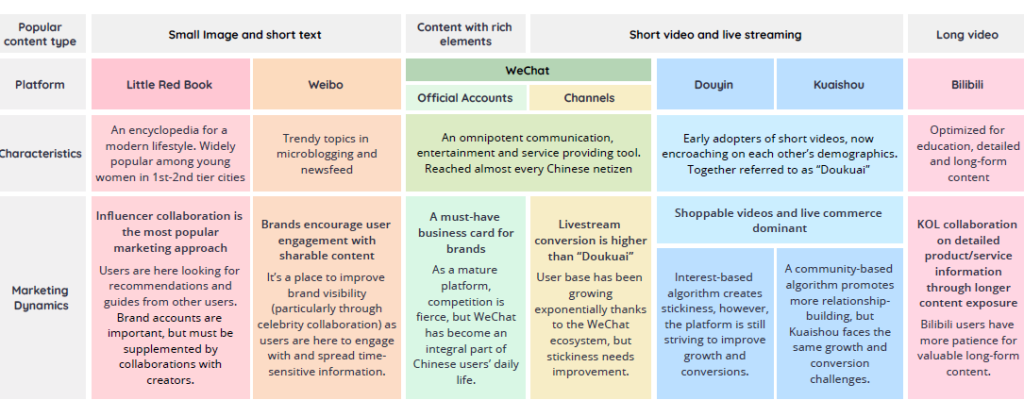China is an attractive market for international businesses, both large and small. And social media is the key to branding and marketing.
With over 900 million active social media users who are highly engaged, social media is integral to the customer journey in China and is a crucial touchpoint for brands who want to transform digital interactions into business results.
Unlike the rest of the world, the social media landscape in China is more dynamic, diverse and competitive. With more than ten homegrown social media platforms, decoding the social media ecosystem in China can seem daunting.
As international businesses develop their marketing plans for China this year, here is what international marketers need to know to successfully leverage opportunities within the country’s vibrant social media scene.
Know your platforms

Among the must-know social media platforms in China, WeChat Official Account (WeChat OA) is an essential social business card for brands, reaching almost every netizen in China. Other popular platforms include WeChat Channels, Douyin, Kuaishou, Little Red Book (Xiaohongshu), Weibo and Bilibili.
Each platform offers distinctive characteristics and features, and while people in China access different platforms to fulfil their various needs, they often do so with a specific frame of mind that aligns with the platform’s unique value proposition and guides their interactions and behaviours.
This means that a single campaign may require multiple social media platforms to execute, and marketers must understand the function and purpose of each platform and customize strategies to provide a specific value for audiences – whether it’s discovery, education, or engagement.
For example, audiences identify with and look to Weibo for trendy topics and discussions. While this is an opportunity for brands to drive visibility and engagement around hot topics, people are not inclined to shop while on Weibo, even through paid campaigns – strategies on this platform should focus on driving awareness and consideration.
It is tempting for marketers to feel the need to create a presence on all the popular platforms (and cover all bases), but to be successful in China, marketers should customize a platform matrix they want to invest in, based on clearly defined objectives and long-term strategies. Across this matrix, marketers also need to establish the right mix of owned, earned and paid campaigns, customizing campaigns to meet audiences’ needs and desires.
Milk metrics to drive content
Against a backdrop where audiences are spoilt for choice and highly demanding, content is the definitive factor for Chinese audiences when deciding where they spend their time and attention. Understanding how the various social metrics correlate to content can provide deep insights into audience behaviours, content quality and the effectiveness of a social media strategy.
For example, when building awareness and page following, marketers should not simply look at follower count, but analyse it alongside engagement metrics. Know your target audience well and focus on providing content that addresses what matters most to them to draw new followers and keep existing audiences invested in the relationship.
Building relationships and trust over time is central to Chinese culture, and it’s imperative for brands to nurture their audiences through an enjoyable content experience if they want them to remain active followers.
Social media audiences in China prefer to be entertained and educated instead of being persuaded to make a purchase. Skits are a great way to provide an entertaining experience while subtly embedding brand values through storytelling and seamlessly introducing products naturally and convincingly.
Successful campaigns can even transcend its original platform, such as through user recommendations on Little Red Book. With this in mind, when analysing metrics for the consideration stage of the funnel, look at data across both the brand account and individual content for a complete picture of whether your content is compelling enough to keep followers engaged.
When it comes to purchasing, sales often occur outside the social ecosystem, both online and offline, and strict data privacy laws in China can make it challenging to gain a complete view and understanding of the effectiveness of social media marketing at this stage in the customer journey. Here, the use of link tagging and shorteners in social posts is one way to gain visibility into sources of leads and if the content is doing enough to convert audiences to purchase.
Set up KPIs for success
With tailored approaches for different social platforms, marketers have the added complexity of measuring the success of campaigns in China. Here’s where it is imperative to set up well-defined KPIs that are specific to each platform and align with business goals. A rule of thumb for Chinese platforms is between two to four KPIs per goal.
When setting KPIs, make calculated assumptions based on past performance and industry benchmarks. Breakdown details for each KPI and set individual audience acquisition or conversion goals per channel. Further detail milestones by smaller periods (e.g. month, season or thematic events like Singles Day) to better assess performance across peak and low periods which will help identify issues early and allow for timely strategy changes.
An integrated assessment approach, using fit-for-purpose metrics will offer a clearer view of the performance of social media strategies. Begin by selecting appropriate metrics to assess the different types of content (e.g. trending discussions vs educational content), then analyse the impact of paid/promoted content separately from organic content.
In the analysis, it’s important to factor in the effort for different types of content. For example, while videos deliver great engagement results, it can take hours to produce and this needs to be carefully considered when setting KPIs. Use a sufficient amount of data to ensure that the results of certain popular or well performing posts don’t have an unreasonable or misleading impact on the overall results.
The influence of Chinese social media goes beyond China’s borders as platforms increasingly attract following from the vast Chinese diaspora across the globe. And with businesses in China actively using social platforms such as WeChat to connect with international customers, unlocking the power of the vibrant social platforms in China is increasingly becoming central for business success in and outside the country.


















